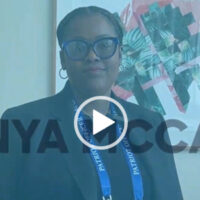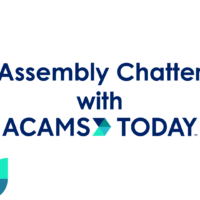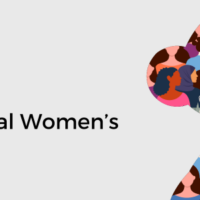
ACAMS Today interviewed Angel Nguyen Swift, vice president of compliance and financial crimes solutions at Enigma, to discuss human trafficking (HT) awareness, Project STAT and the power of collaboration.
Nguyen Swift recently joined Enigma from American Express, where she served as the vice president of the global financial crimes compliance—financial intelligence unit (FIU) and played an active role in re-envisioning and rebuilding the FIU from the ground up. Today, the unit (a centralized global team of more than 300 people supporting the company in over 40 countries) is responsible for the end-to-end suspicious activity report process (monitoring, investigations and reporting), sanctions screening, politically exposed person/enhanced due diligence reviews and anti-corruption payments monitoring.
Since 2015, her mission at American Express was to focus specifically on bringing best in class tools and technology to the virtual desks of compliance personnel at all levels, to maximize capabilities and gain meaningful intelligence in their areas of expertise. Her role at Enigma will give her the opportunity to continue this mission full-time.
Prior to American Express, Nguyen Swift served as a New York County assistant district attorney, where she prosecuted a plethora of cases including street-level violent crimes, sex crimes, and long-term identity theft and cybercrime investigations.
ACAMS Today: You have been in the financial crime prevention industry for more than 17 years. What event(s) sparked you to champion the cause of HT awareness?
Angel Nguyen Swift: There are three things that have allowed me to focus now on HT awareness. First, I recently transitioned to a role that brings me much closer to current and innovative thinking in the data technology space—I’ve literally embedded myself in a technology company. This is giving me firsthand experience to what is actually possible and how to effectively and practically apply it to the real world problems we see in anti-money laundering (AML), such as HT.
Second, the AML industry is at a pivotal moment. For companies who are participating in any part of the financial system—be it traditional banking, cryptocurrency, payment processing, fintech, non-traditional money services businesses, you name it—there is a clear understanding that in order to make it anywhere in this business, you need to make it with technology.
As with all things financial-crime-related, you need to know what to do with the technology. Otherwise, it’s like giving my 3-year-old a hammer and letting her go to town. We have incredibly powerful tools literally at our fingertips, and thanks to the internet and progress of technology to date, we also have a ton of data. We just need to make sure we apply the right balance of human and machine intelligence.
The goal of Stand Together Against Trafficking (STAT) is to do just that for anyone in the financial crimes industry. For financial institutions (FIs), STAT will serve as a platform that will inform FIs on indicators and typologies needed to better identify and report activity indicative of HT. For law enforcement, it will give them insight on how FIs are structured to monitoring activity and profiles; and for nonprofit and research organizations, it will educate them on what information they collect is important and relevant to FIs. For all users, it will give them a common infrastructure with which to share intelligence from various points of view, and because all of this information will be in one place, we will be able to surface patterns and trends that would not have been evident before.
We’re uniquely positioned at this moment in time to take on trafficking through financial disruption (and ultimate eradication). Not only do we, as an industry, have heightened awareness, but we are constantly learning how to be better organized as a whole through the power of collaboration. This has resulted in an immense amount of work dedicated to expanding the boundaries of sharing intelligence across sectors, and is even creating quite a buzz in Congress with new legislation that will make it easier to share information between FIs, nonprofit organizations (NPOs) and law enforcement.
AT: What led to the development of STAT and how did you successfully form partnerships with Polaris and ACAMS in the fight against HT?
ANS: For a long time, I’ve participated in many forums, both open and closed, where amazing collaboration and sharing happens in the AML community. These meetings involve various sectors of the public and private financial crime community. Everyone comes together, often during their own personal time, to discuss how we can best detect financial activity of HT. There is always a huge appetite to share lessons learned, intelligence and information—and an even bigger interest to work together to make bigger and better impacts. But because everyone is juggling multiple things at once (running programs, leading multiple investigations, advocacy work and the list goes on), it’s difficult to drive a focused movement that requires coordinating people from numerous organizations who are balancing an exponential amount of priorities.
For STAT, we were able to find a window of opportunity where there was the right mix of the right place, the right time...and the ability to apply a whole lot of elbow grease. Between Polaris, ACAMS and Enigma, we hit the main factor for success—we could bring together the right group of people to tackle the specific goal of helping FIs better detect and investigate activity that may be indicative of HT, and to do so through an innovative approach involving some technology and data science.
So, forming a partnership with Polaris and ACAMS was the easy part. Both organizations have been heavily involved in helping financial crime professionals think about how to use information and data to detect HT, albeit from different perspectives. Both organizations are respected leaders and influencers in their respective communities, and thus they serve as important gateways to a broader brain trust network. In addition, they are both hyper focused on the importance of collaboration. It was a perfect fit, and all parties were eager to come to the table and get to work.
AT: After multiple years of developing solutions for the fight against HT, could you share how these four stages from Project STAT (ad-hoc monitoring, building a program, influencing externally and innovating new solutions) can define the next chapter in the fight against HT?
ANS: The purpose in developing a maturity model of an FI’s anti-trafficking program was to give some structure and definition to what many FIs are already doing. The most challenging part in building a program is knowing where to start. There is so much ad-hoc benchmarking that happens, that we thought having a common ground on which to start could be helpful. Through this, we hope to also encourage institutions to expand and grow their programs—and give them some tools to do it. Lucky for us, we were able to reach out to our STAT network to ensure that we were covering a broader perspective.
There are so many resources that institutions can leverage. Organizing them and figuring out how to apply them can be overwhelming, so we wanted to map the resources to a structure and to action items that an FI would be able to implement. That is how we thought about the four categories and four stages of maturity. The four categories represent the core elements germane to building any successful program:
- Data: Data is gold. With it, you have the ability to know; with knowledge, you can do things and you learn to make things better and make important decisions. So, knowing your data and having access to it is key.
- Technology: You need the tools to manage, orchestrate and get intelligence from the data. Think 3-year-old with a hammer.
- Policy: A company’s policy against HT is incredibly important. This sets a guiding principle on how the company and its employees should operate in motion—it’s a true opportunity to make a strong statement, bringing awareness to the issue and influencing people’s actions.
- Collaboration: The extent to which a company can collaborate on various issues relating to anti-trafficking work is so powerful. There is nothing more powerful than people working together for good—any amount of this is helpful to the larger anti-trafficking community.
The four stages of maturity represent where FIs see themselves. When we are in a place where institutions can say they are Stage 4 in all categories, we have truly reached the next level as an industry. In the meantime, we want to make this as easy as possible!
AT: As technology changes, traffickers adjust their financial patterns to escape common typologies. Considering the use of electronic transactions and bitcoin as popular payment methods for traffickers, where should FIs focus their data analysis to be one-step ahead of bad actors?
ANS: FIs need to have in place an ingestion agnostic capability or infrastructure that will allow their data to talk to each other. Put another way, they need a strong ontology methodology. This way, even as they continue to build business, products and services, the data they collect in those various areas can be translatable, so that any analysis that leads to pattern or anomaly detection is done with little effort.
To do this, FIs first need to know how all of their data is structured. This means creating one centralized data dictionary or data map of all of their systems. They need to understand what data is being collected, how it’s being collected, how it’s being stored and how it’s being used. Next, they need to create staging area for translation (engine/ontology manager). Because most institutions have complex data and technology infrastructures built over many years, there is a need to create a way for the data to talk to each other. It’s the classic example of comparing apples to oranges. We need to make the oranges apples or apples oranges—and have the ability to continuously do so at scale.
With this in place, people can do what only they can do—apply ever-changing real world scenarios and intelligence.
AT: The STAT resources explain, “They (traffickers) open a variety of accounts tied to different people and locations to avoid detection, and they take advantage of the independence of U.S. banks by distributing money and activities across them.” Could you expand on the formalities of this system for U.S. banks and how it should be modified to identify red flags?
ANS: While information sharing across FIs is possible under 314(b), there are still many hurdles to overcome to access the data in a way where we can truly leverage all of the technology tools available today to identify red flags. It often takes a lot of time to share a little bit of information. First, specific activity is detected, then some investigation or review must be done to determine whether the activity is believed to be money laundering or terrorism financing. Then, a request is sent to a FI that is party to a particular customer. That FI generally conducts a review, and then responses are drafted and sent back. This process often takes weeks, if not longer. This is a difficult pill to swallow, especially with the rate at which we can process and analyze data today.
Currently, I see two ways we can be more proactive in identifying red flags. The first is by pulling together a subset of data fields known to detect certain red flags from a network of FIs. These will be continuously analyzed to determine whether those red flags or indicators present themselves. The second way is to create a universal way for red flags to be deployed systematically into multiple data environments. This would require large-scale efforts at the development stage, but if done correctly, could reap huge benefits long term.
Both of these approaches would require revising current regulations and ensuring appropriate application of those regulations. Many FIs are still taking a very conservative approach to information sharing, and even intelligence sharing under the current laws. This is not because they are not willing to share, nor does it mean there is not an understanding of the importance of sharing. There is still an ingrained fear that there could be grave consequences for the people and company. Some working groups have tried to put something in place to start this process, however, because there is a delicate balancing that needs to occur, progress is slow. The most effective way to get either of these efforts up and running is through a government-led or organized program that involves strong partners in the financial industry and technology.
There is a real opportunity to explore innovative ways of sharing data with the right policy in place. It just needs to be done with the right people at the table.
AT: The use of data represents a key element on the fight against HT. How can FIs leverage the right data through public-private partnerships? Can this type of collaboration reach a new level worldwide?
ANS: This is exactly what we are trying to achieve with STAT. We often hear, “It’s all about the data.” With STAT, we’re aiming to provide a deeper understanding of the data—specifically the who, what, where and how data—that can be used to strengthen detection measures at FIs. With a better understanding of these data categories supplied through STAT, each FI can translate and apply this knowledge to their specific institutions.
Taking this a step further, we can start to identify actual data points on which to search. Hopefully, the new legislation, H.R. 6729, that allows NPOs to share data with FIs will pass and we will start heading in the right direction. Efforts worldwide are already ongoing. We just need to connect the plumbing, and we have started those conversations with international organizations so we can tackle the whole scope.
AT: From community banks to Fortune 500 companies, financial crime professionals come from multiple backgrounds and work environments. What can these individuals do to take a proactive role in the fight against HT?
ANS: First, stay current and aware. To talk about the problem and start solving for it, we need to be informed of how trafficking is evolving and what it looks like. Next, speak up. Be a champion, take on the issue and raise awareness across your place of work.
It’s also important to give back. Participate in collaboration and intelligence sharing with other FIs, law enforcement and NPOs. Remember that we’re fighting a common enemy who can only get one over on us if we are not talking to each other. We’re strongest when we work together, so let's all make an effort to do just that.










